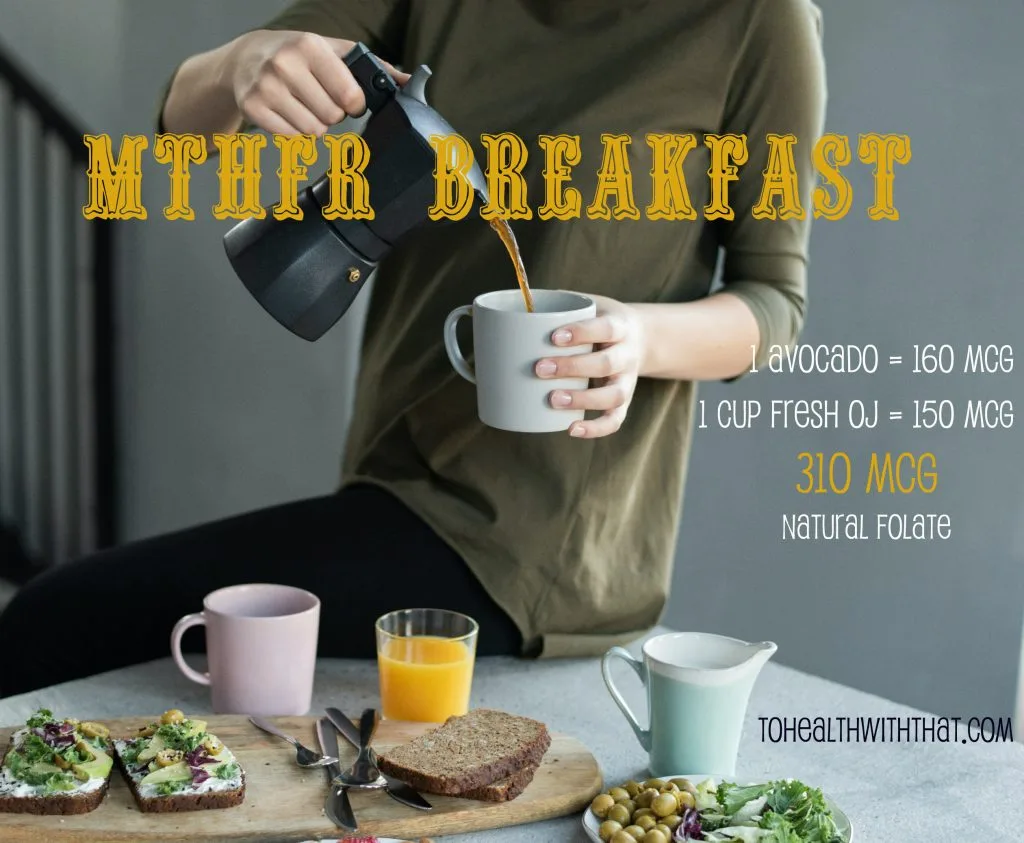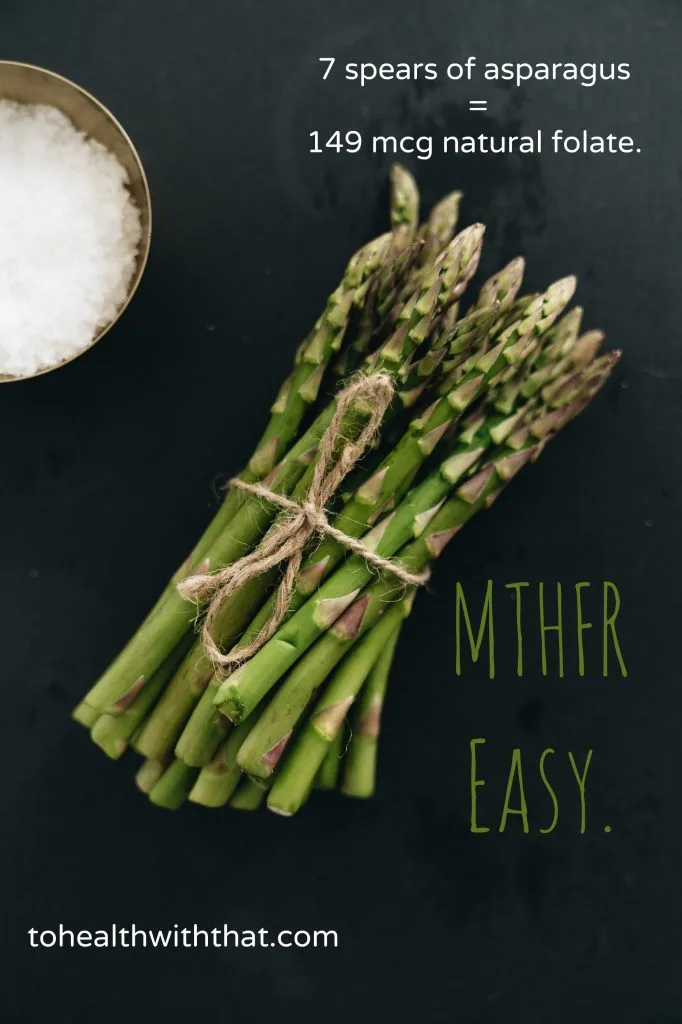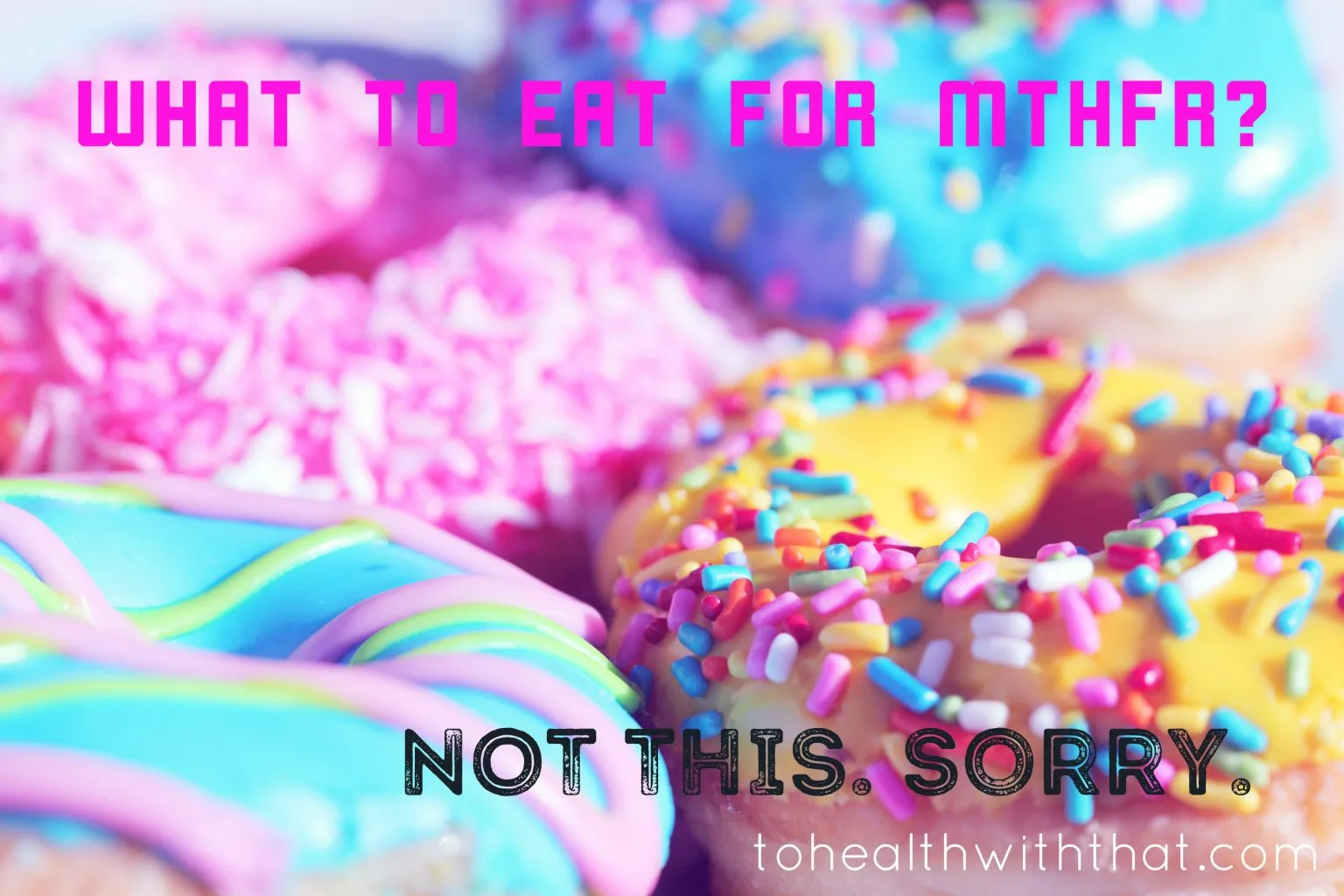We’ve been talking a lot about natural folate and its food sources vs. synthetic folic acid (which is toxic in high doses.). So in theory, we’ve got it. But in reality, what does this actually look like? Let’s dive in right now.
How Much Folate Are We Talking? Do I Have To Bathe In The Stuff?
Not at all. Although MTHFR folks might need to adjust based on their own responses, generally we’re aiming for the same targets as everyone else. The units are in “dietary folate equivalents” because absorption of folate and folic acid are different. Natural folate is about 50% absorbed and folic acid about 85%. If you want to geek out on it:
1 mcg DFE = 1 mcg natural folate = 0.6 mcg artificial folic acid.
According to Harvard University School of Public Health, daily folate needs are:
- Adults: 400 mcg
- Pregnant women: 600 mcg
- Lactating women: 500 mcg
- People who regularly drink alcohol: 600 mcg (because alcohol impairs absorption).
- Children – from 65 mcg up to 400 mcg at 14 years old.

Food Sources of Natural Folate
Naturally occurring folate is present in lots of the foods you might already eat, and also in some that might be new to you. Here are the 10 foods highest in natural folate according to USDA nutrition data:
| Food | Folate per 100g (3.5 oz) | Folate per cup | Related foods? |
| Edamame | 311 mcg | 482mcg | Peas, soybean sprouts |
| Lentils (cooked) | 181 mcg | 358 mcg | Roman beans, black-eyed peas, pinto beans, chickpeas, black beans |
| Asparagus (cooked) | 149 mcg | 268 mcg | Artichokes, beets, okra |
| Spinach | 146 mcg | 263mcg | Turnip greens, pak choi, collard greens |
| Broccoli (cooked) | 108 mcg | 168 mcg | Brussels sprouts, kale, cabbage, cauliflower |
| Marmite (yeast extract) | 100 mcg per 8 g serving | Unhelpfully, the makers of Marmite have listed the folate as “folic acid” because the terms are used interchangeably. It is actually natural folate. | |
| Avocados | 81 mcg | 163 mcg | |
| Mangos | 43 mcg | 71 mcg | Guavas, pomegranate, papaya, kiwi, durian |
| Romaine lettuce | 136 mcg | 64 mcg | Endive, butterhead lettuce, garden cress |
| Sweet corn | 42 mcg | 61 mcg | |
| Oranges | 54 mcg | 30 mcg | Strawberries, cantaloupe, blackberries, honeydew, pineapple |
With MTHFR Mutation, If You Can Eat Your 400 mcg and Avoid Folic Acid, You’ve Pretty Much Nailed It.
Of course, there are lots of times when it isn’t quite so simple, but this is a nice easy benchmark to strive for. So – What to eat for MTHFR? Lots of beans, veg, and fruit. No problem. The much harder part is what not to eat.

With MTHFR mutation, if you can eat your 400 mcg of natural folate and avoid folic acid, you’ve pretty much nailed it.
– Amy Neuzil
What Not To Eat For MTHFR Folks
There is a small list of fortified foods that have added synthetic folic acid that should be avoided (also, all vitamins and supplements with folic acid). The list is short but impactful. Here it is:
- Enriched wheat flour
- Enriched corn flour
There – That wasn’t so hard, was it? Except it turns out it is hard because here are all the foods that are made with those two things.
- Bread
- Cereal
- Pasta
- Crackers
- Cookies
- Corn chips
- Tortillas
- Baked goods
- Baking mixes for cakes, cookies, brownies and whatnot.
This is very much where the wheels fall off the cart because, in the West, most people don’t really know how to eat without hefty doses of bread, pasta, crackers, and cereal. It is just how we are used to eating.

What to Eat for MTHFR – Substitutions
With every substitution, be sure to read the label. If folic acid is listed in the ingredients (or fortified or enriched flour), then it’s a no-go. Also, remember that if you’re just buying flour and making it yourself (go you!), then you still have to make sure you get un-enriched flour – usually, this is gluten-free, organic, or specialty.
| Fortified Food | MTHFR-Safe Substitution (usually. Read your labels.) |
| Bread | Organic bread, 100% rye bread, gluten-free bread, sprouted bread, rice cakes |
| Cereal | Organic cereals (sometimes), oatmeal (sometimes – usually not the instant ones), |
| Pasta | Rice noodles, gluten-free noodles, organic pasta (don’t forget, rice and potatoes are still on the menu!) |
| Crackers | Rice crackers, rice cakes, Some rye crackers, most organic crackers |
| Cookies | Gluten-free cookies, organic cookies. |
| Corn chips | Organic corn chips, bean chips, |
| Tortillas | Organic tortillas or sprouted tortillas. |
| Baking flour | Organic flour, brown rice flour, gluten-free baking mix, wheat alternative flours like buckwheat or sorghum. |
This Sounds Like a Big Change
It is a big change from the typical Western diet, but it’s a very doable change – especially now when there are so many products designed for people with gluten sensitivities or people looking for organics. Still, it takes some commitment, especially at first, while you’re getting used to your new normal.
Why Do This?
The payoff from this one change can be really significant. Many people report better energy, more stability in moods, reduced brain fog, increased attention, and even better hormone balance. Also, if you’re trying to get pregnant, this sets you up for a healthier pregnancy. That still doesn’t make it easy, but it does make it worth it.
This is The Foundation For a Healthy Life With MTHFR Issues
Many of us MTHFR folks can reduce or resolve any MTHFR related issues just by following this diet. There are a few exceptions.
- MTHFR folks with very low serotonin – sometimes these folks can’t tolerate any folate intake and have to avoid folate-rich foods along with fortified foods (although cutting out the fortified foods will make a huge positive difference). We’ll talk about this in detail next week.
- Some overmethylators – MTHFR folks with symptoms usually fall into one of two categories. Overmethylators or undermethylators. Undermethylators are more common and usually need higher doses of folate to manage symptoms. Overmethylators are less common and sometimes need very low doses of folate to manage their symptoms. I happen to be an overmethylator but I still eat a very high-folate diet and occasionally supplement so it’s very individual. We will talk more about over- and under- methylators in September.
MTHFR is a common genetic mutation that can contribute to anxiety, depression, fatigue, chronic pain, infertility, and more serious conditions like breast implant illness, heart attack, stroke, chronic fatigue syndrome, and some types of cancer. If you know or suspect you have an MTHFR variant, schedule a free 15-minute meet-and-greet appointment with MTHFR expert Dr. Amy today.
Book Your Appointment

This was a great article. I really appreciate listing the foods that can and cannot be eaten. I have also read that foods with high levels of methionine Should be avoided. This includes eggs poultry fish etc. This confuses me? I thought these were foods that could be eaten?
Hi Julie,
Honestly, this is one of those issues that confuses everyone because different practitioners have different opinions. The idea behind avoiding protein-rich foods is that if you don’t get as much methionine then you won’t make as much homocysteine. That is true, but also flawed because we all need good protein for a million other things in our bodies, so it isn’t a great long-term strategy. I am of the opinion that all of the foods that are high in methionine are your best protein sources (especially eggs, which are also high in choline and choline can really help a flagging MTHFR). So I always suggest eating a moderate protein diet – paleo or any other protein-heavy diet is never a good idea for MTHFR folks. If you are getting good natural sources of folate and doing the rest of the basics then your methylation should be happening and avoiding methionine isn’t really helpful. I hope this makes sense!
I am appreciating all I am reading to learn as quickly as possible to better care for my granddaughter with compound heterozygous mthfr. Dr has been absolutely no help on this matter and every place I read has different advice from avoiding folate rich food to eating more of it.
Hi Tiffany,
Yes – it’s really hard to find knowledgeable practitioners for us folks with MTHFR issues. I’m so glad you found the site and also that you’re willing to advocate for and protect your granddaughter – she’s lucky to have you.
How do you find out whether you’re an undermethylator or an overmethylator? Is this something you monitor by checking your folate levels? I’m new to all this and just requested blood work but not entirely sure what to make of the results when I get them
Hi Kristen,
Great question, and honestly it isn’t that easy. The best way to tell which category you fall into is by symptoms. Keep in mind “overmethylator” and “undermethylator” are kind of legacy terms, but this isn’t something we can test unless we have access to research-grade equipment to test overall DNA methylation. So, take a look at your personality, your symptom picture, and your traits. Also, if you join genetic rockstars there is a downloadable worksheet in the MTHFR Library that you might find helpful.
What about 100% whole wheat bread? As long as it doesn’t say enriched/fortified is it still ok?
Hi Kelly,
Great question! If it’s 100% whole wheat and the label doesn’t say enriched/fortified and there is no folate listed in the nutrition label, then it should be ok. You can always call the manufacturer as well and check directly with them – that is usually the best option if you’re not entirely sure. Thanks for being here!
The pepperidge farm whole wheat bread says only “whole wheat flour” but in the nutrition facts it says “folate 10mcg DFE (0mcg folic acid).” Is that trustworthy since it actually says ZERO folic acid?
thank you!
Hi Katie,
Great question, and it sounds like it’s trustworthy! The aren’t technically allowed to lie on labels, so I think if they specified zero folic acid, it’s the truth. Great find!
Thank you! One more question: “durum wheat semolina” is the only ingredient in the pasta I got? It doesn’t mention folic acid or folate anywhere on the nutrition label, but online, it says that durum wheat is high in folate/folic acid. Is this a good source of folate or something I should avoid? Thanks again!!
If it only says “durum wheat semolina” then it is probably an unenriched/unfortified form of wheat that is fine for MTHFR mutants. I doubt that it has a significant amount of natural folate, but the good news is that it also sounds like it doesn’t have unnatural folic acid, so that’s a bonus. 🙂
Hi I was wondering which rice is best to eat? I have been doing Brown Jasmine Rice but now not evn sure which rice is not enriced with folic acid anymore. Is it best to do Organic Brown Rice? Thank you
Hi Jennefer,
This is such a tough one and honestly, I don’t have a great answer. Typically rice does have to say somewhere on the package if it’s fortified or not, so that’s a good thing, but I’ve also brought rice home and eaten it for days before finding some tiny print somewhere that says it’s had things added to it, so there’s that. I really like the flavor of brown jasmine and brown basmati so those are usually what I stick to. Organic would be a safe bet if you can find it! Good luck and if you find the magic formula here, I’m all ears. 😉
Just want to say that this is one of the best MTHFR articles I’ve read. The article is very informative & definitely written in lay persons terms. With all of the research I have been looking through, this is the easiest to absorb. Thank you so much!
Hi Annamarie,
I’m so glad to hear it! If anything is unclear just reach out – I am an MTHFR mutant too and it’s important to me that other people on this journey really understand and find their own answers
I carry a double mutation of A1298C. I’ve been researching benefits of freshly milled organic grains. I’ve been gluten free for years but I feel like fresh milled bread is biblical fir a reason . Do you see any reasons to not try this?
Hi Tina,
I have no problem with freshly milled organic grains – grains can be very healthy. Obviously, if you’re gluten sensitive then stick to non-gluten-containing grains, but fresh milling is fabulous. Let me know how you like it!
Hi Amy, I was wondering if we could get in touch somehow. I have some MTHFR questions, mostly food related. I am very disappointed with my doctor’s because they are telling me that having this is no big deal and that there is no proof that my symptoms are coming from MTHFR. Thank you.
Absolutely! You can schedule a free 15 minute meet and greet here: https://calendly.com/amy-tohealthwiththat/15min That way I can help you find the best path forward for you. I can’t answer medical questions in the meet and greet, but we can figure out if it makes sense to work one-on-one, if it’s best for you to join genetic rockstars, or take a course, or whatever.